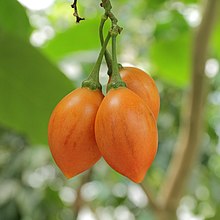Cyphomandra betacea
| Tamarillo | |
|---|---|
 |
|
| Scientific classification | |
| Kingdom: | Plantae |
| (unranked): | Angiosperms |
| (unranked): | Eudicots |
| (unranked): | Asterids |
| Order: | Solanales |
| Family: | Solanaceae |
| Genus: | Solanum |
| Species: | S. betaceum |
| Binomial name | |
|
Solanum betaceum Cav. |
|
| Synonyms | |
|
|
The tamarillo is a small tree or shrub in the flowering plant family Solanaceae (the nightshade family). It is best known as the species that bears the tamarillo, an egg-shaped edible fruit. It is also known as the tree tomato,tamamoro, and tomate de árbol in South America.
The tamarillo is native to the Andes of Ecuador, Colombia, Peru, Chile, and Bolivia. Today it is still cultivated in gardens and small orchards for local production, and it is one of the most popular fruits in these regions. Other regions of cultivation are the subtropical areas throughout the world, such as Rwanda, South Africa, Darjeeling and Sikkim in India, Nepal, Hong Kong, China, the United States, Australia, Bhutan and New Zealand.
The first internationally marketed crop of tamarillos in Australia was produced around 1996, although permaculture and exotic fruit enthusiasts had increasingly grown the fruit around the country from the mid-1970s on.
In New Zealand, about 2,000 tons are produced on 200 hectares of land and exported to the United States, Japan and Europe. For the export, the existing marketing channels developed for the kiwifruit are used.
The tamarillo is also successfully grown at higher elevations of Malaysia and the Philippines, and in Puerto Rico. In the hot tropical lowlands, it develops only small fruits and fruit setting is seldom.
...
Wikipedia
